EcoIP for your Home or Business
Sustainable solutions designed around you.
Custom-
Every sustainable solution is custom designed and unique to your home or business. (We do however offer packages for certain energy spends but please do contact us via email and a price list will be sent to you.)
Flexibility-
As your life evolves, so does your system with you.
Reliability-
Watch your new sustainable solution work for you, for up to 30 years guaranteed.
Savings-
Our sustainable solutions will save you money in real time

Whether you want full POWER independence or partial independence, EcoIP has you covered.
How PV Solar Power Works

Solar Panels
Your panels produce power from sunlight.

Appliances
Appliances are run using power from your system.

Inverter
Converts solar power Direct Current (DC) to Alternating Current (AC) to power your home or business.

Batteries
Batteries are used to store excess power from sunlight.

Grid
Any excess solar power your system produces can be fed back into the grid, allowing for quicker ROI through net metering. You also able to draw power from the utility depending on what setup you prefer.
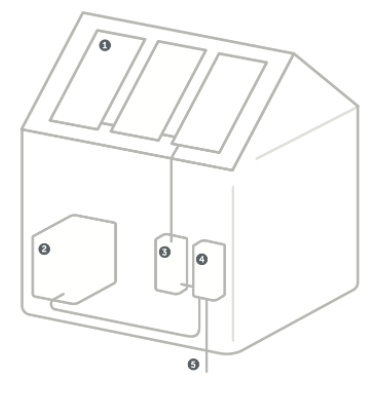
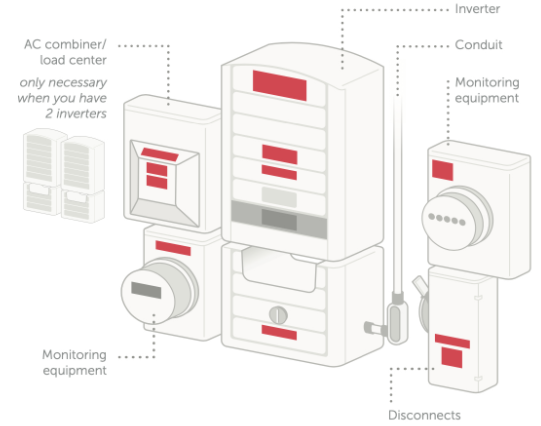
Balance of System ( BoS)
Balance of System is a general term used to describe the electrical equipment installed for solar systems. This includes inverters, disconnects, AC combiner/load centers, monitoring equipment, and any associated wireways.
Why is BoS equipment important?
The equipment that composes the Balance of System is where the rubber meets the road for a PV system. It includes the disconnects needed to allow for safe operation and servicing, the metering devices necessary to insure the system is performing as promised, and the inverter, which changes the Direct Current (DC) power from the array to the Alternating Current (AC) power that your home or business uses. It will always be well labeled.
A Photo Voltaic (PV) Solar system consists of: a solar array (panels), a solar panel combiner, a solar regulator, an inverter and a storage battery bank (if the system is not a grid tie system, a grid tie system is normally installed without backup or battery banks). The system can convert solar rays into AC power.
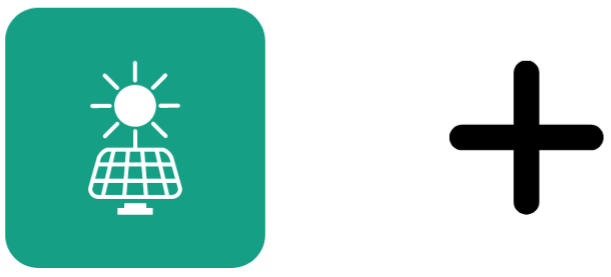
PV modules produce direct current (DC) from sunlight

Inverters convert the direct current into usable grid-suitable alternating current (AC) and monitor the system.

You benefit from free, abundant POWER, which makes you more independent.
Let EcoIP help you understand which Solar PV setup is best for your home or business.
The destiny of your POWER independence is in clear sight...
There are three main types of solar system setups
Which solar system will be most suitable to you will be dependent on your location, energy needs, budget and the reason you’re deciding to install a solar system

Grid-tied Solar PV system
Grid-connected solar systems without battery storage are the most commonly installed systems. These systems are connected to the grid and do not require a battery storage, however it is possible to add battery storage to a grid-connected solar system if the inverter is a hybrid and compatible.
How it works: grid-connected solar systems have solar panels that absorb the sun’s rays. These rays are then converted to Direct Current (DC) Energy. The DC energy is then fed through the solar system’s inverter which turns the DC energy into Alternating Current (AC) energy. Once converted to AC electricity a household will run off this instead of energy from the electricity grid or battery.
A house/business that has a grid connected solar system will pull from the electricity grid as a secondary source of electricity if the solar system is not producing enough energy.
If you have a grid-connected solar system, any energy generated from your solar system that you use is essentially free. Any excess energy is sent to the grid (unless you have battery storage) and you will receive reimbursement in the form of a Feed-in Tariff.
Hybrid Solar PV system
Hybrid solar systems work similar to the above grid connected solar system setup but with the added benefit of battery storage for any excess energy generated by the solar system.
A grid-connected solar system with battery storage ( Hybrid ), stores the excess energy generated by a solar system for the home/business to use when the solar panels are not generating electricity from the sun e.g. at night.
How it works: Hybrid systems have solar panels that absorb the sun’s rays. These rays are then converted to Direct Current (DC) Energy. The DC energy is then fed through the solar system’s inverter which turns the DC energy into Alternating Current (AC) energy. Once converted to AC electricity a household will run off this instead of energy from the electricity grid or battery.
If some of the energy generated by the solar system is not used by the household, it is then stored in the battery as a second source of electricity for use when the solar system is not generating energy e.g. at night. If the battery does not have enough energy for the house/business to run when the solar system is not producing energy, the house/business will then pull electricity from the grid as a third source of electricity.
Adding battery storage to a grid connected solar system gives more energy independence and less reliance on the electricity grid but with the added safety net of being able to pull electricity from the grid, in times when a solar system is not producing enough energy.

Off-Grid Solar PV system
An off-grid solar system, is also called a stand-alone system. These types of solar systems are not connected to the grid and require battery storage. Off-grid solar systems are usually only found in rural areas that have difficulties connecting to the grid.
For a home/business to run on a off-grid solar system the solar system must be designed to be able to produce enough energy for the household to run, as well as enough excess energy to fully charge the battery, so that the household will have power when the solar system is not generating enough or any energy.
An off-grid solar system does not have the electricity grid to fall back on as a third source of electricity, so it must have a big enough solar array and battery storage system in place. Some off-grid systems do use backup generators installed as a third energy source, however these can be expensive to buy and to run.
If Solar is not a viable option at present, partial POWER independence is still possible with a robust Load Shedding system.
Can you afford to let your home or business go through yet another power cut?
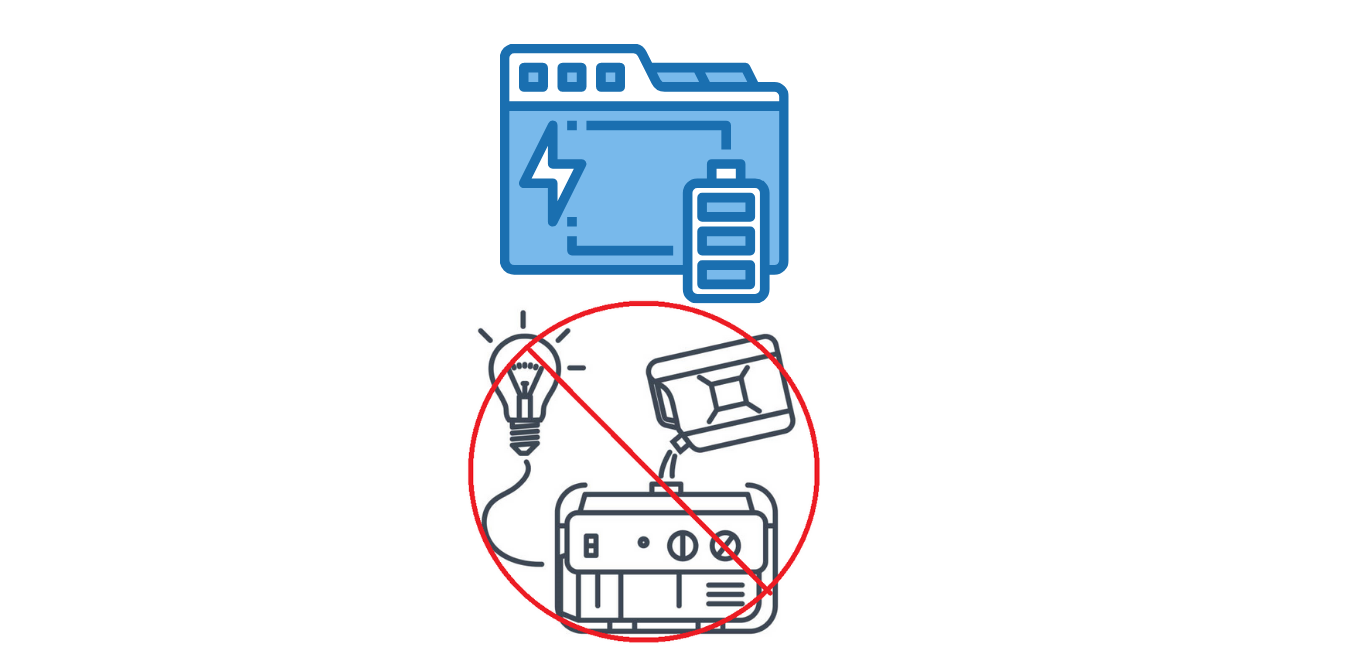
Battery backup for long power failures aka the dreaded Load Shedding
Our battery backup solutions are well suited for any home, SOHO or SME and have advantages and benefits that far outweigh anything that fuel power generators can offer.
Advantages of Batteries/UPS's over Fuel generators:
Connects to the grid rather than fuel sources which means a much lower carbon footprint.
They are silent,smooth & effective compared to generators that are much noisier..
Much more cost effective long term as much less maintenance is required and no need to buy fuel on an on going basis.
If set up inteligently, they could save you peak hour power costs.
How do these load shedding battery backups work?

Power for low strain appliances, we've got you covered

Power for high strain appliances, we've got you covered too
Understanding what you can do with either a Lite or Robust Battery backup system...
The unit is permanently connected to utility power so that while mains is present the extra large built-in battery charger recharges the batteries and keeps the batteries fully charged until a power failure occurs. The equipment you want to back up is also permanently connected via the system. In case of a power failure the backup system automatically switches over, via an extra fast transfer switch to the inverter, which will continue to provide power to the equipment within 15 msec. This is extremely fast and standard equipment like TVs, DSTV decoders, microwaves, fans, etc. are unaffected. The sinewave systems can also backup computers but it is possible that a very small percentage of computers could reset during the switchover time ( For these scenarios where keeping power on is critical to backing up information, we suggest UPS's incorporated into the solution.
When utility power returns, the whole procedure is reversed and the unit will switch back to utility power and will automatically start re-charging the batteries. Your equipment remains connected to the system even when power is restored. The whole process is fully automatic.
Understanding system run-time and battery charge time...
The amount of backup time is determined by the size of the connected battery bank and the load drawn from the system. The backup time is directly in proportion to the load drawn. The backup time is normally calculated at full load (i.e. if the system is a 2200VA system, full load is 2200VA). If you remove some of the connected load, then the backup time will be extended accordingly.The recharge time of the batteries depends on how much power was removed from the batteries during a power failure. To begin with the system has to be correctly sized. These systems are capable of bridging power outages from 2 – 24 hours as the battery chargers are powerful enough to recharge the battery bank to cater for the second outage on the same day. Again this process if fully automatic.
Need Critical Load Protection?
Then a UPS should be built into any sustainable solution.
What is an Uninterruptible Power Supply ( UPS )?
The purpose of a UPS is to provide emergency power (usually by a lead/acid battery) to a load when it senses that the input power source has failed. They are different from emergency power systems or standby generators because they provide near-instantaneous protection from power interruption by using a battery (which can be a supercapacitor or flywheel).
The battery itself usually has a short runtime (about 5-20 minutes), but it should be enough to either save all that precious data/progress that you have made, gracefully shut everything down, or fix the problem that caused the outage.
A UPS can be used to protect hardware like data centers, computers, and other electrical equipment where an unexpected surge/sag can cause serious problems like data loss, business disruption, and even injuries or fatalities
Types of Uninterruptible Power Supplies
There are three types of uninterruptible power supplies: static, dynamic (rotary), and hybrid. Static uses power electronic converters, dynamic uses electromagnetic engines (generators and motor), and hybrid uses – you guessed it – a combination of both static and dynamic. Let’s take a look at how these topologies are commonly used for electronics.
Offline/Standby UPS
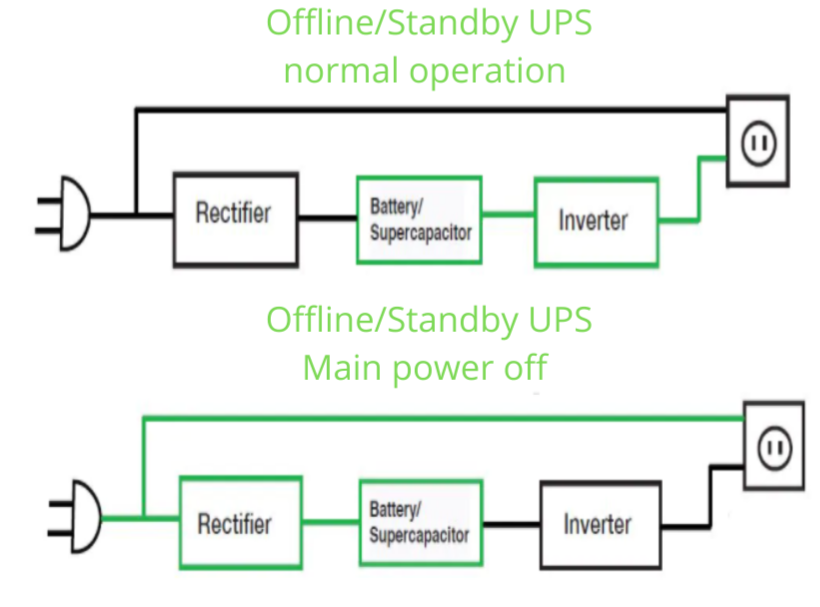
The offline/standby UPS is the most basic out of the three. It provides light surge protection and battery back-up. During normal operations, it gets its power from its main power source (generally an AC outlet). Once it senses that the main power source goes beyond acceptable limits or fails, it switches to the “offline/standby” battery where it will then go to the DC/AC inverter – as such, there will be a small transfer time between the main power source and battery.
What’s usually in a standby/offline uninterruptible power supply?
Most standby/offline UPS have a switch to either run on the main power source or the battery component. The majority of the bulk is in the battery component, as the main power supply goes to the AC/DC rectifier that charges the battery. After that it goes into a DC/AC inverter to output into the load.
Online/Double Conversion UPS

The online/double conversion UPS differs from the offline/standby as the DC/AC inverter is always connected on. This means there will be no transfer time between the main power source and battery, providing greater protection against spikes, sags, electrical noise, and complete power failure.
What’s usually in an online/double conversion uninterruptible power supply?
The main power source in double conversion UPS goes into the AC/DC rectifier even during normal operations, so it must go through a DC/AC inverter every time, hence the term “double conversion.”
Line-Interactive UPS
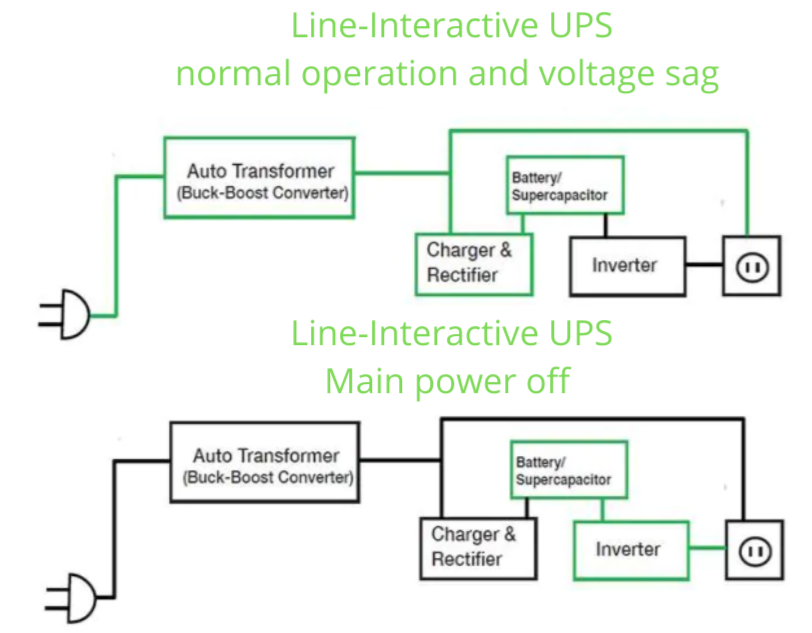
The line-interactive UPS has a similar design to the offline/standby, but with properties of an online/double conversion as well. The line-interactive design can handle small under-voltages and over-voltages (about 20% from its standard voltage) by using a multi-tap variable voltage autotransformer or buck-boost converter. Even during these small under/over-voltages, the battery is not being used and is still being charged until there is a big under/over-voltage.
This type of UPS system will provide backup to enable you to save your work and shutdown your computer after a power failure and is also designed to regulate the output voltage and prevent, to a large degree, any spike, sags and blackouts from reaching your sensitive equipment (ranging from computers and telecommunications systems to computerized instruments).
What’s usually in a line interactive uninterruptible power supply?
The design is similar to offline/standby, but it either has an auto-transformer or a buck-boost converter on the main line. This will either boost the voltage for under-voltages or buck the voltage for over-voltages.
Lets go full circle together
Being Power Independent becomes even more potent when you start lowering your overall carbon footprint.
Would you buy a Tesla and charge it with a fuel generator?
That's why at EcoIP we not only make you POWER Independent but look at your entire home or business topology and do a comprehensive energy audit.
We are the only sustainable solutions provider that will guarantee dropping your communications, document solutions and surveillance carbon footprints by up to 96% in most cases and pride ourselves upon this, what that means is a cleaner happier planet and what that really means to you is a positive bottom-line that will make your pockets glad that you've partnered up with EcoIP.
Take the first step towards independence.
Get free insights sent straight to your inbox and a special gift for going on this journey with us.
© 2022 EcoIP. All Rights Reserved.


